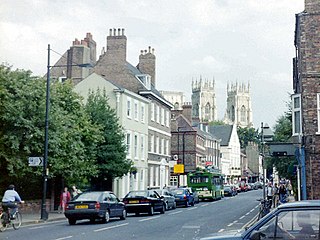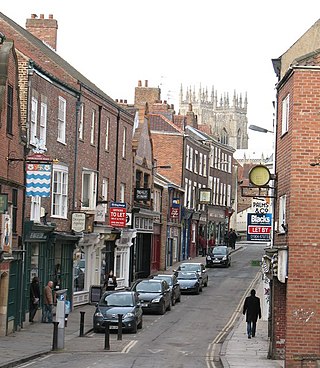
Bootham is a street in the city of York, in England, leading north out of the city centre. It is also the name of the small district surrounding the street.

York has, since Roman times, been defended by walls of one form or another. To this day, substantial portions of the walls remain, and York has more miles of intact wall than any other city in England. They are known variously as York City Walls, the Bar Walls and the Roman walls. The walls are generally 13 feet (4m) high and 6 feet (1.8m) wide.

Broad Street is a wide street in central Oxford, England, just north of the former city wall. The street is known for its bookshops, including the original Blackwell's bookshop at number 50, located here due to the University of Oxford. Among residents, the street is traditionally known as The Broad.

St Saviourgate is a historic street in the city of York. St Saviour's Church was built here in the 11th-century, and the street was first mentioned in 1175, as "Ketmongergate", street of the flesh sellers.

Micklegate is a street in the City of York, England. The name means "Great Street", "gate" coming from the Old Norse gata, or street.

Stonegate is a street in the city centre of York, in England, one of the streets most visited by tourists. Most of the buildings along the street are listed, meaning they are of national importance due to their architecture or history.

Lendal is a street in the city centre of York, in England.

Blake Street is a road in the city centre of York, in England.

Fossgate is a street in the city centre of York, in England.

Walmgate is a street in the city centre of York, in England. During the Medieval period, the street was the site of a seafissh and cattle market. Walmgate Bar, was involved in the Siege of York in 1644, during the First English Civil War. During the 20th century, many of the older buildings were cleared away and newer structures put up.

Duncombe Place is a street in the city centre of York, in England.

Museum Street is a road in the city centre of York, in England.

Petergate is a street in the city centre of York, in England. It is divided into High Petergate and Low Petergate. The well-known view of the Minster from Low Petergate is described by the City of York Council as "excellent".

Marygate is a street in York, England, running just north of the city centre. Built in the Middle Ages, it gets its name from St Mary's Abbey and the Viking word "gata," meaning street. The area where the street lies was outside the walls of the Roman city of Eboracum, and represented the northern limit of the settlement; to the north, the land was used only for burials. The street runs south-west, from Bootham, down to the River Ouse.

Ogleforth is a street in the city centre of York, in England.

Lawrence Street is a road in York, in England, immediately south-east of the city centre.

College Green is an open space in the city centre of York, England.

Peasholme Green is a street on the eastern edge of the city centre of York, in England.

Feasegate is a street in the city centre of York, in England.





















